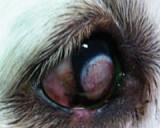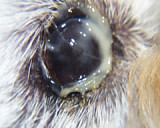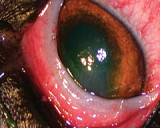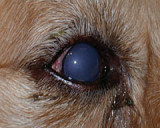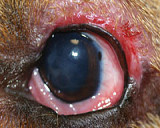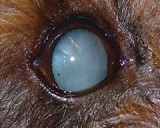Feline conjunctivitis is a doxycyline deficiency!
If you have been to any of our CE sessions you may have heard the mantra “feline conjunctivitis is a doxycycline deficiency”. But surely no feline ever expired through lack of doxycycline! So do we mean? The two most common causes of infectious feline conjunctivitis are feline herpes virus (FHV) and Chlamydophila felis.
FHV is of course a virus and won’t respond to doxycyline but coinfections are common. Other less common causes are Mycoplasma felis, which will respond to doxycycline, and rarely calicivirus which is usually self-limiting.
Symptoms
How to identify FHV and C.felis conjunctivitis
Kittens: Upper respiratory disease is a common comorbidity. FHV can result in serious sequelae such as symblepharon (conjunctival tissue adhering to the cornea or eyelids), corneal ulceration, and in serious cases, corneal perforation. Many kittens end up with scarred nasolacrimal ducts that become narrowed and result in watery eyes for life that are unresponsive to any treatment.
Adults: URT disease is much less common as some immunity exists. Generally the clinical presentation gives a clue to the underlying cause. Any corneal ulceration (Fig 1A, 1B) indicates FHV as the cause. A severe chemosis (Fig 1C) is more suggestive of C.felis, especially if there was a 10 day interval between unilateral presentations.
Treatment
What about cytology or PCR?
These can be considered especially in cases of unusual presentation or chronicity but otherwise can be unreliable. Almost all cats are vaccinated against FHV so will yield false positives. The intermittent nature of C.felis shedding also makes accurate detection difficult, however this is worth considering for identification of carriers in multicat households or cattery situations. Cytology using Geimsa staining can identify C.felis inclusion bodies in conjunctival epithelial cells but is rarely done even in specialist clinics.
Treatment of feline conjunctivitis
Doxycyline: 5 mg/kg BID for 21 days, treat all cats in the household. The long course is due to the highly infectious nature of C.felis and the short duration of immunity. This course can be reduced if the conjunctivitis is mild, especially as this long course can be quite expensive. Systemic treatment is necessary to eradicate from the uro - genital tract OR Azithromycin 5mg/kg SID every 3 days for 4 treatments or a one-off dose of 20mg/kg, especially if multiple cats are being treated. (This last dose is widely used but has not been tested). Topical anti-inflammatories: may be needed after 10 days of oral doxycycline if the conjunctiva is still inflamed. Voltaren(R) twice daily should be sufficient. Avoid corticosteroids if corneal involvement or a history of FHV. Try Acular(R) If Voltaren(R) irritates. Systemic anti-inflammatories: may be needed in very severe cases. Meloxicam is a good choice.
When should I consider antivirals?
Corneal ulceration is an indication for anti-viral medication. If you stain a dendritic or geographic ulcer then use antivirals. It’s too late if a sequestrum has already developed. Cidofovir was a extremely effective topical anti-viral but is no longer available. Oral Famciclovir is effective but can be tricky to get into cats in an adequate dose and frequency due to the size of the tablets. It can also be obtained as a compounded preparation in fish paste.
- Kittens: quarter of 125mg tablet twice daily until healed, usually 3-7 days
- Adults: 40mg/kg BID-TID until healed(10-14 days)
ALWAYS treat kitten conjunctivitis with a topical antiviral—human Zovirax at 6 times daily can be effective.
TAKE NOTE: NEVER GRID A CATS EYE - this will promote FHV recrudescence and increase the risk of development of a corneal sequestrum (right).
Management
Other management considerations.
Stress can promote viral recrudescence so conjunctivitis with or without corneal involvement often follows a period of stress - owner absence, moving house, new cat, new child, visit to vet - and treatment for conjunctivitis! So sometimes a delicate balance is needed.
Lysine has been shown to slow viral replication but there is no good clinical evidence for an exact dosage - we recommend 1/4 tsp (500mg) BID whilst active and 500mg sid long term.
Hyaluronate eye drops: these can be obtained over the counter and are useful for improving the health of the feline cornea after resolution of conjunctivitis. Luxyal and Hylo-Forte are brands that we use.
Other Causes
What about other causes of conjunctivitis?
Although infectious causes are the main reason for primary feline conjunctivitis, allergy can also occur. Secondary causes include entropion (especially in older cats that lose their retro-orbital fat pads and brachycephalics), uveitis, glaucoma, dry eye and neoplasia - so ALWAYS do a thorough eye examination at every visit.
